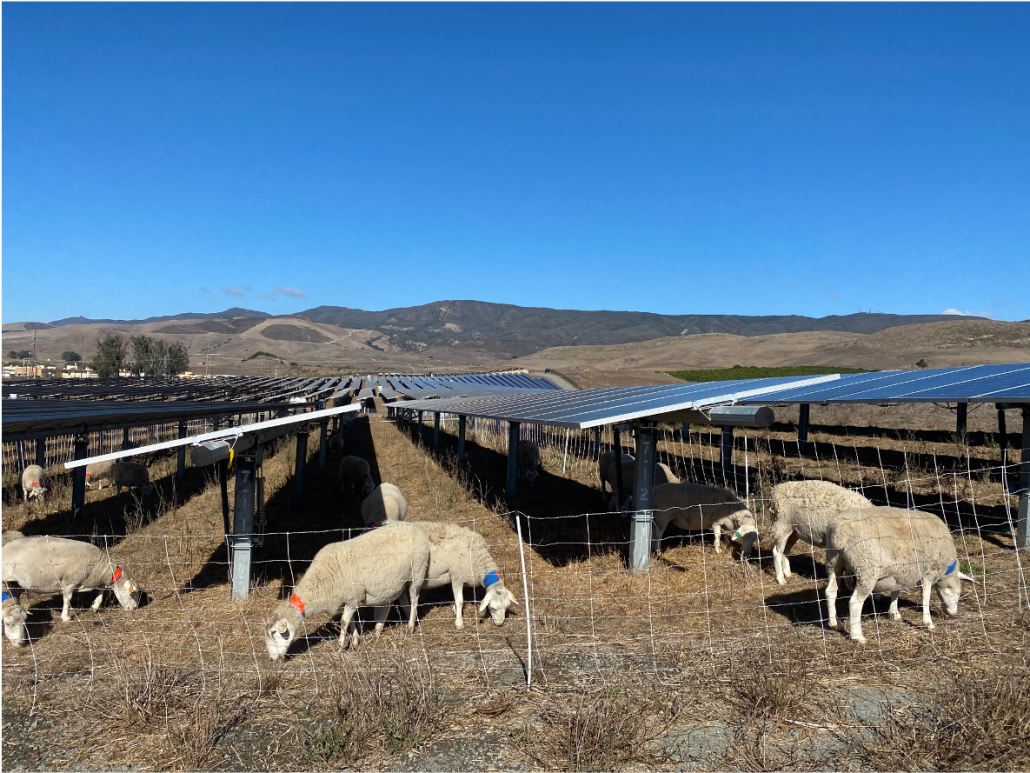This life cycle assessment study investigates the environmental performance of sheep-based agrivoltaic systems and concludes that agrivoltaic systems are superior to conventional ground-mounted PV systems because they have dual purposes and reduce the environmental impacts associated with producing food and electricity.
Tag Archive for: Sheep
Written By: Alex Delworth, Clean Energy Policy Associate; Center for Rural Affairs
Just off the campus of Maharishi University in Fairfield Iowa, sits a 1.1-megawatt (MW) solar farm. Beneath the panels, a flock of sheep and their newborn lambs are grazing, while beginning rancher Emily Mauntel and her Australian Shepherd Ziggy stand back and admire their work.
Solar farms pose a considerable opportunity for multipurpose agricultural uses in rural spaces. Iowa has seen a rapid increase in solar project development the past two years. According to the Solar Energy Industries Association, the industry is expected to add another 1,304 MW—a 250% increase over current installed capacity—during the next five years. Depending on the type of technology installed, this could mean between 6,520 and 13,040 acres of land will be used for solar production. With proper local siting, these projects will be required to plant and maintain native vegetation underneath the panels. This increase in open pasture presents a unique opportunity to combine traditional land uses with renewable energy development, such as pollinator habitats or open grazing for livestock. An opportunity Emily has already begun benefiting from.
Originally from Michigan, Emily relocated to Fairfield to attend Maharishi International University. While completing a three-month internship at a goat farm in Oregon as part of the university’s Regenerative Organic Agriculture certificate program, her interest in livestock grew. After the internship, she remained in Oregon for another year, working for various livestock operations and gaining experience in the industry. In late 2021, she moved back to Fairfield to work on the university’s vegetable farm and help her peers in their respective livestock businesses.
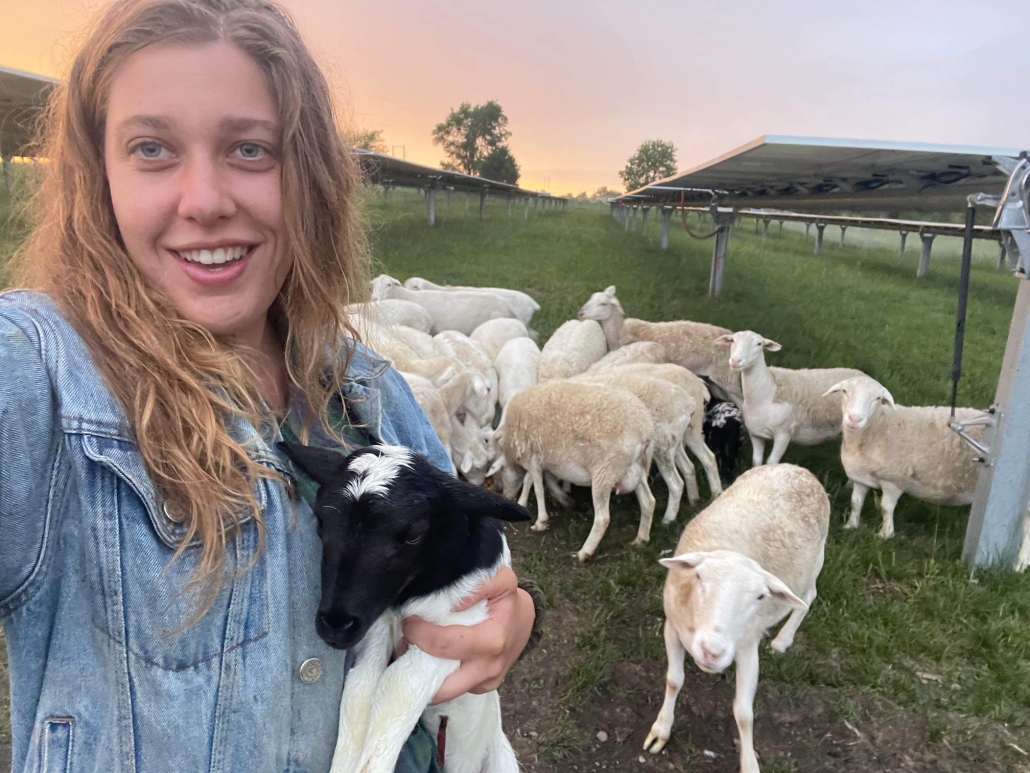
One day she and a friend were driving past a large solar array in Minnesota and noticed how the infrastructure was perfect for sheep grazing. They knew about the array in Fairfield, which is owned by the university and operated by Ideal Energy, a local solar company. She contacted the solar company to pitch the idea first and gained their approval before approaching the university. Both parties were ecstatic because the university had been looking for somebody to graze livestock and Ideal Energy saw an opportunity to avoid spending about $5,000 for annual landscaping, according to the company. Emily said the two parties came to an agreement that she would graze the array, which provided her an opportunity to access pasture in exchange for landscaping the solar farm. With this agreement, Emily benefited by not having lease payments for the time her sheep were on the farm, saving her approximately $360 per month according to Iowa State University’s land lease estimates, or about $2,520 for 2022.
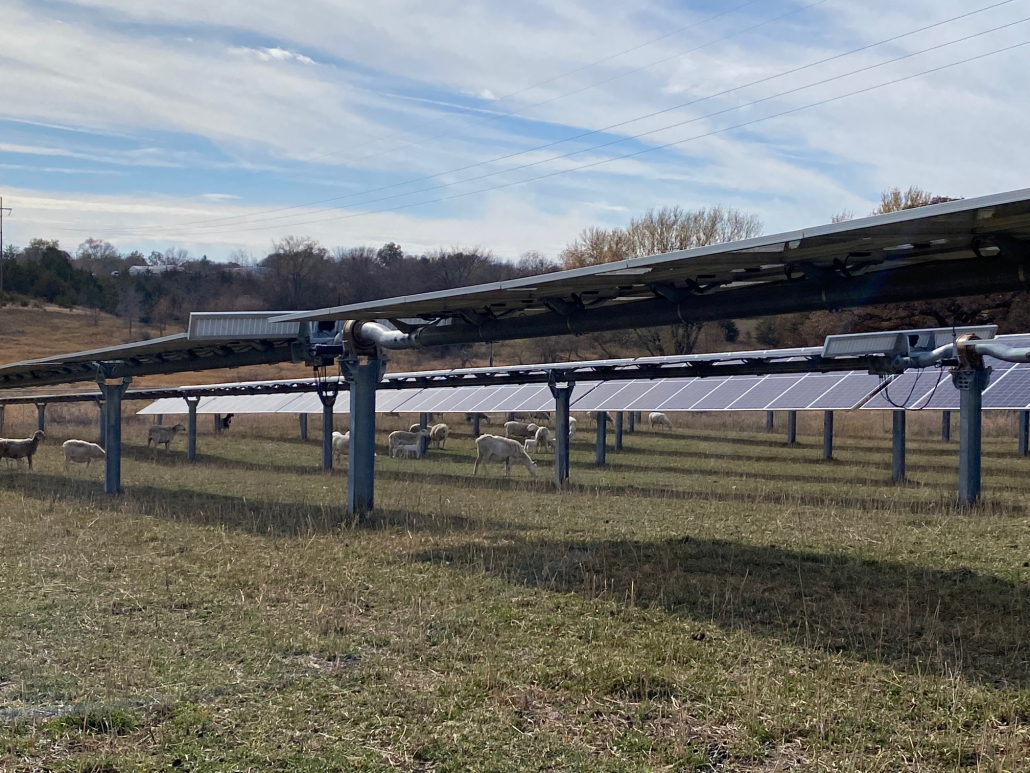
Once Emily had approval, she and her friend went into business together and purchased a 30-head herd of sheep from an auction in Texas. In May 2022, 29 ewes and one ram were dropped off on the six-acre, 1.1-MW solar farm. Before purchasing the herd, she surveyed the land and determined that, given the amount of growth on the site, she would be able to graze five sheep per acre. That is two more than usual because of how lush the plant life was on the property. The site was planted with a mix of flowering prairie species, including clover, fescue, broad-leaf plantain, and others, which served as a good food source. The sheep were allowed to roam freely throughout the solar array, something Emily said worked well. Overall, she believes rotational grazing would have been more efficient but would have required a larger investment due to the cost of a moveable fence.
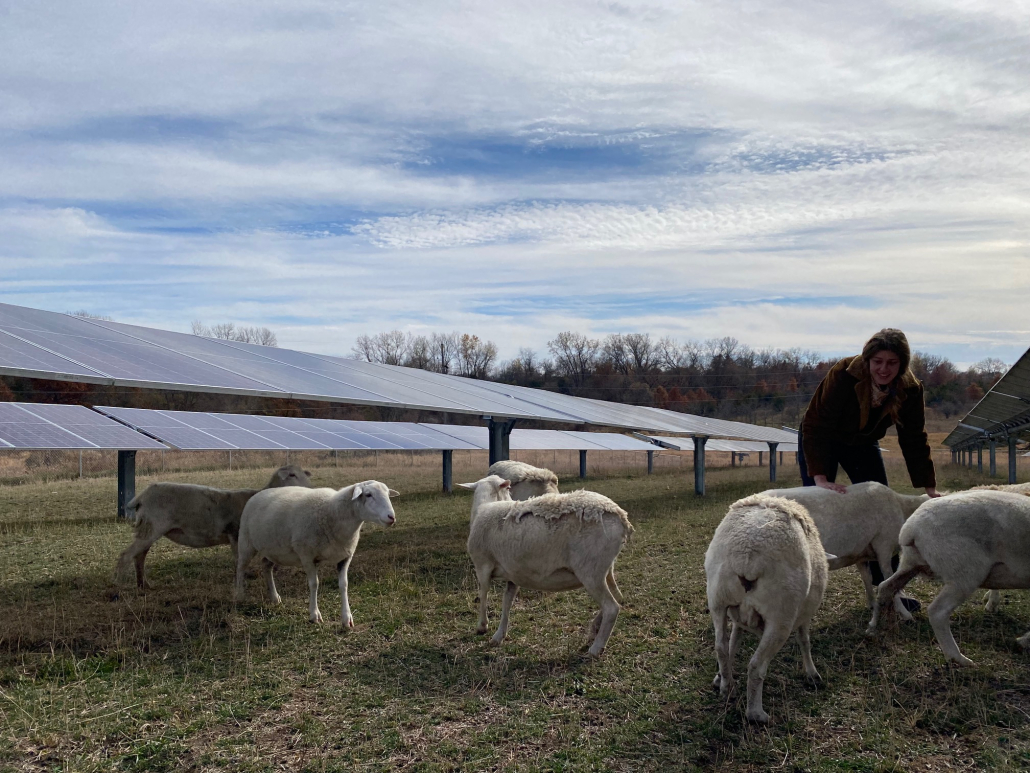
What makes this story especially interesting is that the agribusiness model directly addresses two major issues beginning farmers face—access to land and infrastructure. A 2017 survey by the National Young Farmers Coalition found that land access was the number one issue their respondents faced. Young farmers, according to the survey, are also the most inclined to rent, which makes finding land with the right infrastructure more difficult.
The Fairfield solar site’s infrastructure made the land even more attractive to Emily. She said it had sufficient fencing to hold her sheep and keep out predators. Due to the required native vegetation management, it also had plenty of food for the sheep, which means she never had to supplement food for them, except a mineral feed mix for nutrition. A water source to fill up the livestock troughs and an access road straight up to the gate also proved beneficial. Considering all of these factors, Emily was able to cut a lot of costs throughout the process.
Newly energized by the experience she has gained through solar grazers and managing her own livestock, Emily is now looking to return to the West to continue ranching. She and her business partner plan to sell their herd. Emily hopes to see the solar grazing model continue on the site, saying it has been a perfect opportunity for her to gain experience in the industry, and she believes it will be a great opportunity for the next person, as well.
Emma W. Kampherbeek, Laura E. Webb, Beth J. Reynolds, Seeta A. Sistla,
Marc R. Horney, Raimon Ripoll-Bosch, Jason P. Dubowsky, Zachary D. McFarlane
A study led by Emma Kampherbeek (Wageningen University & Research, the Netherlands) highlights multiple benefits of coupling solar energy production to sheep grazing in rangeland systems. This project investigated how sheep use solar arrays as a forage site and the impacts of solar array presence on forage quality in a California Central Coast site with a Mediterranean climate. Sheep with access to solar panels graze more than when they are on nearby native rangeland without an array. This increased foraging behavior is likely driven by a combination of the protection that the array provides the sheep from weather conditions, which increases grazing time, as well as increased protein content and digestibility of forage with the array footprint.
AgriSolar Clearinghouse partner Rob Davis has generously offered a full Solar Farm Lego set as a prize for the winner of the competition for best photo taken at one of the Follow the Sun tour field trips.
This set is priceless and can not be purchased. If you support the idea of a real-life Lego set being commercially available, vote here: LEGO IDEAS – Solar Farm. For a great background on the kit, see this NREL blog.
Please post your Follow the Sun photos to our forum here, or tag us on social media by using the hashtag #AgriSolar.
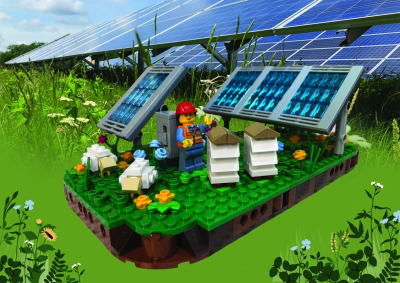
Solar Farm Lego Set. Photo: Rob Davis
The Follow the Sun Tour launched in Arizona, at Biosphere 2 and the Manzo Elementary agrivoltaic research site, and it was a great educational, inspirational, and networking event. Next up, we will travel to Minnesota on August 4 to tour Enel North America’s Lake Pulaski agrisolar site, US Solar’s Big Lake agrisolar site, and Connexus Energy’s agrisolar site in Ramsey. We’ll end the day on a sweet note with an Enel-sponsored Solar Farm to Table™ event featuring foods grown or pollinated at agrisolar sites. Get your free tickets here: Events – AgriSolar Clearinghouse.
The next week, we’ll travel to Massachusetts for a tour of the University of Massachusetts South Deerfield agrisolar research site and then the Million Little Sunbeams solar and hay farm, capping off the day at Knowlton Farms. Get your free tickets here: Events – AgriSolar Clearinghouse
In September, we will join forces with Jack’s Solar Garden, Sprout City Farms, and our partners at NREL and University of Arizona to tour Jack’s Solar Garden during its annual Night on the Farm. Stay tuned for details.
Over the next year, we’re planning more field trips to central California, Texas, Oregon, Virginia, Idaho, New York, and many more sites. If you have a site you’d like to highlight with an AgriSolar Clearinghouse fieldtrip, we’d love to hear from you. We’re looking forward to seeing you on the road!
By Emma Kampherbeek
Land is limited. Agriculture, electricity production, housing, nature, etc. all compete for the same plot of land. In some areas more than in others, but the competition is everywhere. On top of that, greenhouse gas emissions keep increasing and the global temperature keeps rising, leading to more frequent natural disasters and parts of the earth becoming uninhabitable. We shouldn’t only focus on stopping the global temperature from rising, but also on climate change adaptation and multifunctional land use now that ‘good’ land is getting scarcer.
It makes sense to have at least dual land use, but preferably use land for three, four or even more purposes. Agriculture and electricity production are a really good fit that can create win-win situations. That’s why I researched what I like to call ‘Solar Sheep’ – sheep that perform vegetation management on solar farms.
A lot of research is currently being done on the impacts of solar farms on soil health and biodiversity of flora and fauna. But what about sheep? Sheep are very effective grazers, which means that they are perfect for vegetation management on solar farms. Unlike goats, sheep don’t jump on the panels and don’t chew the wires. Unlike cattle, they are not heavy and large, which means that they can easily graze under the panels. They are also great with different types of terrain, like steep, rocky hills, which are hard to navigate for (robotic) mowers. These are a few of the advantages of sheep for solar farm owners.
How about advantages for the sheep? Is it also a positive experience for them to graze under solar panels? As many farmers who use their sheep for vegetation management on solar farms can tell you, sheep really don’t seem to mind grazing under and between the solar panels. This is also what my research showed, which was conducted on Gold Tree Solar Farm in San Luis Obispo, CA, in January 2021. Sheep on the solar farm grazed more than sheep in the natural rangeland without solar panels (see Figure 1). The solar panels provide shade and protection to the sheep. This prevents them from experiencing heat stress and protects them from harsh weather conditions, which will happen more frequently in the face of climate change. I live in the Netherlands, so heat stress didn’t use to be a big issue here, but in the last decade cases and mortality of heat stress have increased significantly.
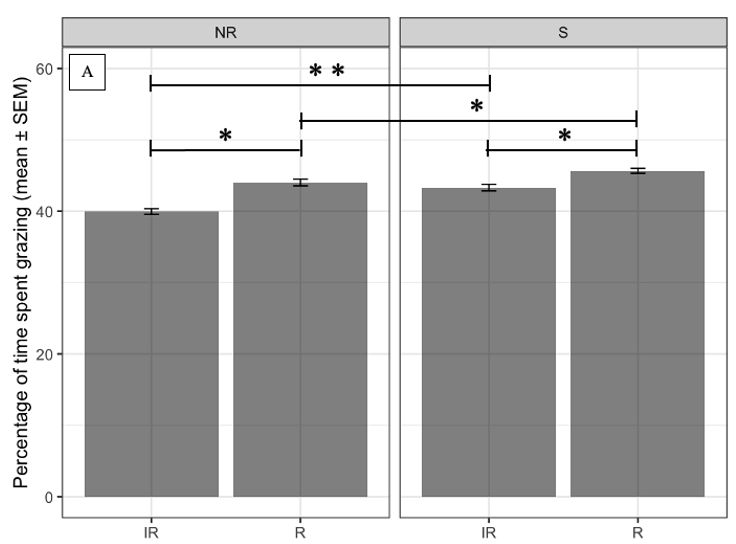
Figure 1 Bar graphs showing the mean (± SEM) of the total percentage of time spent grazing during the Main study over the total period of sixteen days of both treatment groups (NR & S) and both management types (R & IR).
* P < 0.0001, ** P = 0.0015, *** P = 0.031. (S = Solar; NR = Native Rangeland; R = Rotational; IR = Intensive Rotational).
The article is now under peer review but will hopefully be published later this year in the Journal of Applied Animal Behaviour Science as an open-access article.
By Dr. Seeta Sistla, Natural Resources Management and Environmental Sciences Department, Cal Poly, San Luis Obispo
With the dual growth of utility-scale solar energy and food production, fallowed agricultural landscapes represent a particularly promising area for the deployment of solar arrays because these systems have the potential to recover with shifts in management practices (Tscharntke et al., 2012; Wright et al., 2012). California is a national leader of both solar energy development and agricultural production. As water becomes scarcer and costlier, there is growing tension between land-use choices centered around maintaining conventional agricultural systems, transitioning land to renewable energy farming through solar energy development, shifting agricultural strategy (e.g., conventional to conservation farming), or alternate land uses (e.g., housing development).
Placing solar arrays on farmland and other human-modified landscapes represents a promising area to unite energy production with ecological restoration and the sustained conservation of ecologically valuable land. The potential for ecologically improving degraded landscapes with targeted solar array placement will be governed by biogeochemical interactions between abiotic and biotic factors (Figure 1). Despite the potential ecological and economic synergistic benefits that coupling these land uses could create, the impacts of solar arrays on fallowed farmland and other disturbed landscapes are not well understood.

To address this deficit, we are studying the direct and indirect effects of utility-scale solar energy in conjunction with sheep grazing on soil and plant characteristics. This work includes collaborating with agricultural stakeholders, undergraduate and graduate students, and solar developers (Figure 2).

To date, we have found that land in the direct footprint of the array panels hosts a plant community with increased nutrient content and forage quality and maintains a greener plant community for longer periods than the surround area. These findings likely reflect reduced water stress due to shading in our arid western landscapes, highlighting the potential synergy between carbon-free energy production, rangeland management, and water conservation (Figure 3). Our group continues to investigate these plant and soil responses to array placement at two solar sites on the Central Coast of California and looks forward to opportunities to collaborate with others.

References
Tscharntke, T., Y. Clough, T. C. Wanger, L. Jackson, I. Motzke, I. Perfecto, J. Vandermeer, and A. Whitbread. 2012. Global food security, biodiversity conservation and the future of agricultural intensification. Biological Conservation 151:53–59.
Wright, H. L., I. R. Lake, and P. M. Dolman. 2012. Agriculture-a key element for conservation in the developing world. Conservation Letters 5:11–19.
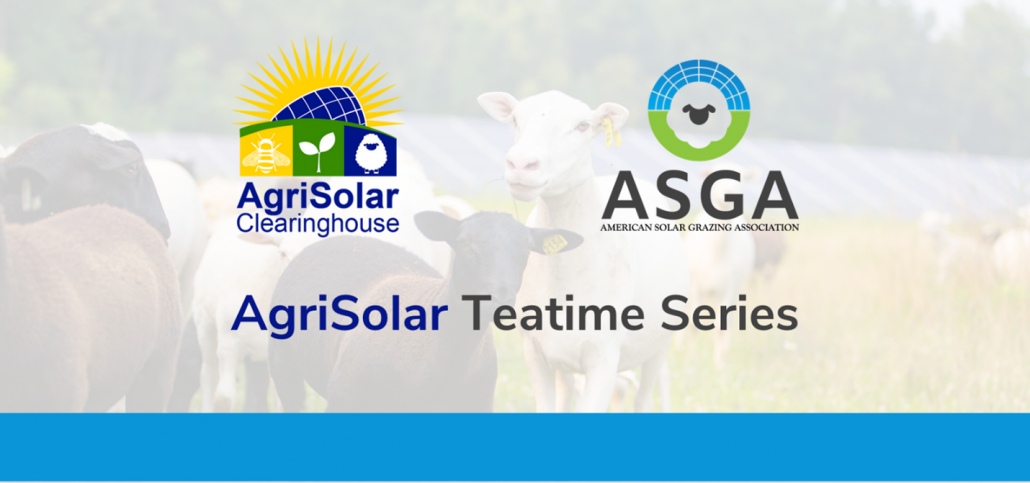
The AgriSolar Clearinghouse is partnering with the American Solar Grazing Association to run a series of joint educational agrivoltaic webinar presentations, known as Teatimes. These events are free and open to the public, and recordings will be broadcast on the AgriSolar Media hub if you can’t make the live event.
The series will start April 21, with the presentation Leasing for Community and Grid-Scale Solar – Key Considerations While Negotiating, by Tom Murphy, the Director of Penn State’s Marcellus Center for Outreach and Research (MCOR). To join the webinar, use this link, meeting ID, and passcode:
Zoom link: https://us02web.zoom.us/j/81562414717?pwd=b2xnQ3hCQk1nMkh3aGM5dzRHS2JIZz09
Meeting ID: 815 6241 4717
Passcode: 414544
ASGA is founded by farmers for farmers and solar professionals. They swap stories, best practices, and good ideas about solar grazing. We are excited to bring their valuable experience and expertise to the AgriSolar Clearinghouse network and hope this partnership will help foster connections, promote best practices, and provide support for solar graziers around the country.
Check out our events page for future dates, topics, and sign-up information.
This publication discusses the principles and practices of grazing multiple species of livestock on pastures. Here, you’ll find a discourse on the benefits of multispecies grazing on productivity and profitability, including its positive impacts on pasture diversity and health. Also covered are grazing dynamics (how diverse animal species use grazing resources), the types and kinds of fencing and working facilities needed by various animals, and how to deal with predators, mineral supplementation and parasites. These considerations and topics can be useful when developing agrisolar operations that include livestock.
This study was conducted to compare lamb growth and pasture production under solar panels and in open pastures in Corvallis, Oregon in spring 2019 and 2020. Results of the study dynamics of variations of shaded areas for rabbit habitat, seasonal herbage and forage production. These results can be useful in developing agrisolar operations that include rabbits.
A recent episode of ATTRA Sustainable Agriculture podcast Voices from the Field takes a look at solar grazing, the practice of using livestock to manage the vegetation under solar panels. Sheep are widely considered the best animal for solar grazing, and they are being used in many countries with great success.
National Center for Appropriate Technology Livestock Specialist Linda Coffey talks with Lexie Hain, a co-founder of the American Solar Grazing Association. Lexie, who began grazing sheep at solar arrays in 2016, talks about how she began solar grazing and offers practical tips for anyone who is considering the practice.
With agricultural land in high demand and requirements to expand renewable energy, using land for agriculture and energy at the same time is better for the environment, the solar company, the farmers, and the sheep.
ATTRA Resources:
Other Resources:
This podcast is produced by the National Center for Appropriate Technology through the ATTRA Sustainable Agriculture program, under a cooperative agreement with USDA Rural Development. ATTRA.NCAT.ORG.

